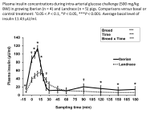
ESTELLÉ Jordi
- UMR 1313 GABI (Equipe GéMS), INRA, Jouy-en-Josas, France
- Animal genetics, Animal health, Bioinformatics, Genomics, Gut function, Gut microbiology, Immunogenetics, Metagenomics, Monogastrics, Statistical genetics
- recommender
Recommendation: 1
Reviews: 0
Recommendation: 1

Determining insulin sensitivity from glucose tolerance tests in Iberian and Landrace pigs
Iberian pigs: more than excellent ham!
Recommended by Jordi Estellé based on reviews by 2 anonymous reviewersIberian pigs represent a treasured resource that allows the maintenance of their “montanera” traditional breeding system and, thus, contributes to the socioeconomic sustainability of the rural areas in the south-western regions of Iberian Peninsula. While the excellence of Iberian meat products is widely recognized, the idea of using Iberian pigs as biomedical models is currently emerging. Interestingly, due to the particular fatty acid metabolism of this porcine breed, Iberian pigs have been proposed as models for type 2 diabetes (Torres-Rovira et al. 2012) or obesity-related renal disease (Rodríguez et a. 2020).
In the present manuscript, Rodríguez-López et al. provide further insights on the particularities of “obese” Iberian pigs by comparing their insulin sensitivity in a glucose tolerance test with that of commercial “lean” Landrace pigs. The authors compared four Iberian pigs with five Landrace pigs in an intense time-series following an intra-arterial glucose tolerance test and measuring insulin, glucose, lactate, triglycerides, cholesterol, creatinine, albumin and urea plasma levels. Several of these parameters showed significant differences between both breeds, with some of them being compatible with an early stage of insulin resistance in Iberian pigs. These results are relevant from an animal production perspective, but provide also further evidence for considering the Iberian pigs as a suitable biomedical model for obesity-related disorders.
References
[1] Torres-Rovira, L., Astiz, S., Caro, A., Lopez-Bote, C., Ovilo, C., Pallares, P., Perez-Solana, M. L., Sanchez-Sanchez, R., & Gonzalez-Bulnes, A. (2012). Diet-induced swine model with obesity/leptin resistance for the study of metabolic syndrome and type 2 diabetes. The Scientific World Journal, 510149. https://doi.org/10.1100/2012/510149
[2] Rodríguez, R. R., González-Bulnes, A., Garcia-Contreras, C., Elena Rodriguez-Rodriguez, A., Astiz, S., Vazquez-Gomez, M., Luis Pesantez, J., Isabel, B., Salido-Ruiz, E., González, J., Donate Correa, J., Luis-Lima, S., & Porrini, E. (2020). The Iberian pig fed with high-fat diet: a model of renal disease in obesity and metabolic syndrome. International journal of obesity, 44(2), 457–465. https://doi.org/10.1038/s41366-019-0434-9 "